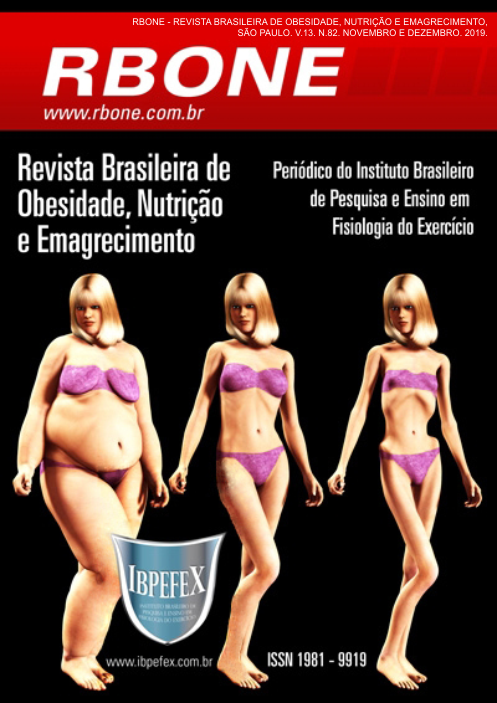Habits consumption among teenagers of a private school
Abstract
Introduction: adolescence is characterized by a period of intense development linked to manifestations of sexuality, physical, emotional changes, and increased nutritional demands. Teenagers are more vulnerable to develop inappropriate eating habits, contributing to excessive weight gain, increasing the risk factors associated with diseases. The school is a privileged space, has the mission to educate and develop human values, at the same time must act as mediator of knowledge and educate their students to opt for the practice of healthy lifestyle. Objective: to evaluate the profile and food consumption among teenagers through the choices of snacks during the school break. Materials and methods: the analysis was performed in descriptive form of quantitative character with cross-sectional delineation. Held with students of a private educational institution in the city of Montes Claros-MG. The sample consisted of 52 students of both genders, aged 13 to 16 years of basic education. Result: through the responses obtained from food frequency questionnaire (QFA), educational activities as guidance and assistance about proper nutrition can be developed within the school space. Discussion: the research revealed disturbing data about adolescents' food profile. The nutritional quality, given the choices of students, can result in serious health problems in later life, such as the chronic non-communicable diseases (CNCDS´s). Conclusion: there is an urgent need to develop strategies that promote changes in eating habits of adolescents towards health maintenance and prevention of future diseases.
References
-Alves, Y.F.; Silva, C.R.; Spinelli, M.G.N. Teor de sódio e contribuição calórica de alimentos ultraprocessados no cardápio de uma unidade de alimentação e nutrição escolar em São Paulo-SP. Revista da Universidade Vale do Rio Verde. Três Corações. Vol. 15. Num. 1. p. 428-436. 2018.
-Araujo, D.S. Avaliação nutricional, mastigatória e da qualidade de vida de crianças com sobrepeso e obesas. Universidade Estadual de Campinas-Unicamp. Piracicaba-SP. p. 2-3. 2014.
-Brasil. Orientações para a coleta e análise de dados antropométricos em serviços de saúde: Norma Técnica do Sistema de Vigilância Alimentar e Nutricional -SISVAN / Ministério da Saúde, Secretaria de Atenção à Saúde. Departamento de Atenção Básica. Brasília. Ministério da Saúde. 2011.
-Brasil. Guia alimentar para a população brasileira / ministério da saúde, secretaria de atenção à saúde, departamento de atenção Básica. 2ªEdição. Brasília-DF. Ministério da Saúde. 2014.
-Carvalho, C.A.; Fonseca, P.C.A.; Oliveira, F.P.; Coelho, A.A.; Arruda, S.P.M. Consumo de energia e macronutrientes no lanche escolar de adolescentes de São Luís, Maranhão, Brasil. Cad. saúde colet. Vol. 22. Num. 2. p. 212-217. 2014.
-Correia, A.M.; Carvalho, F.E.; Martins, R.C.B.; Bassoli, A.C.S. Consumo alimentar de escolares em cantinas da rede privadade municípios do oeste paulista. Omnia Saúde. Vol. 11. Num. 1. p. 15-28. 2014.
-Ferreira, J.T.; Lemos, J.; Dal Bosco, S.M.; Adami, F.S. Alimentação na escola e estado nutricional de estudantes do ensino fundamental. Revista Brasileira em Promoção da Saúde, Fortaleza-CE. Vol. 27. Num. 3. p. 349-356. 2014.
-Leal, G.V.S. Fatores associados ao comportamento de risco para transtornos alimentares em adolescentes na cidade de São Paulo. Tese Doutorado em Nutrição em Saúde Pública. Faculdade de Saúde Pública. Universidade de São Paulo. São Paulo. p. 15-16. 2013.
-Pinto, V.L.X.; Lima, L.; Inda, R.T.; Medeiros, M.; Bezerra, I.W.R. Educação permanente de professores: a reflexão-ação na promoção da alimentação saudável nas escolas. Extensão em Foco, Curitiba-PR. Editora da UFPR. Num. 10. p. 37-58. 2014.
-Raphael, L.B.M.; Righi, C.G.B. Avaliação antropométrica de crianças e adolescentes nas curvas de crescimento: Uma revisão da literatura. Revista UNILUS Ensino e Pesquisa. Vol. 13. Num. 32. 2016.
-Santana, J.T.; Furtado, M.B.; Pinho, L. Promoção do consumo de frutas e verduras em adolescentes: Relato de experiência. Rev enferm UFPE online. Recife. Vol. 8. Num. 1. 2014.
-Silva, J.G.; Teixeira, M.L.O.; Ferreira, M.A. Alimentação na adolescência e as relações com a saúde do adolescente. Texto contexto -enferm. Vol. 23. Num. 4. p. 1095-1103. 2014.
-Veiga, G.V.; Costa, R.S.; Araújo, M.C.; Souza, A.M.; Bezerra, I.N.; Barbosa, F.S.; Sichieri, R.; Pereira, R.A. Inadequação do consumo de nutrientes entre adolescentes brasileiros. Rev. Saúde Pública, São Paulo. Vol. 47. Num. 1. p. 212-221. 2013.
-Vieira, M.V.; Del Ciampo, I.R.L.; Del Ciampo, L.A. Hábitos e consumo alimentar entre adolescentes eutróficos e com excesso de peso. Rev. bras. crescimento desenvolv. hum. Vol. 24. Num. 2. p. 157-162. 2014.
-Zancul, M.S. Consumo alimentar de alunos nas escolas de ensino fundamental em Ribeirão Preto-SP. Faculdade de Medicina de Ribeirão Preto. Ribeirão Preto-SP. p. 60-68. 2004.
Copyright (c) 2020 Mauro Célio Ribeiro Silva, Géssica Aparecida Queiroz dos Santos, Kátia Pina Sepúlveda Hott

This work is licensed under a Creative Commons Attribution-NonCommercial 4.0 International License.
Authors who publish in this journal agree to the following terms:
- Authors retain the copyright and grant the journal the right of first publication, with work simultaneously licensed under the Creative Commons Attribution License BY-NC which allows the sharing of the work with acknowledgment of the authorship of the work and initial publication in this journal.
- Authors are authorized to enter into additional contracts separately for non-exclusive distribution of the version of the work published in this journal (eg, publishing in institutional repository or book chapter), with acknowledgment of authorship and initial publication in this journal.
- Authors are allowed and encouraged to post and distribute their work online (eg, in institutional repositories or on their personal page) at any point before or during the editorial process, as this can bring about productive change as well as increase impact and impact. citation of published work (See The Effect of Free Access).






